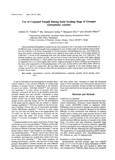Use of copepod nauplii during early feeding stage of grouper Epinephelus coioides

Associated URL
www.jstage.jst.go.jpDate
1999Page views
290Metadata
Show full item recordCited times in Scopus
Share
Abstract
Newly-hatched Epinephelus coioides larvae were stocked in five 5-ton tanks at an initial density of 25, 000 ind/tank. Copepod nauplii were propagated in four of these tanks by inoculating various densities (20 to 80 ind/l) of mixed copepodids of Acartia tsuensis, Pseudodiaptomus spp., and Oithona sp. three days before stocking larvae. Rotifers were added in these tanks on Day 7 at an initial density of 5, 000 ind/l. Larvae in the remaining tank were fed rotifers (only) starting Day 2 at 5, 000 ind/l. The feeding incidence, gut content, growth, and survival of larvae were better in tanks with higher density of copepodids (60-80 ind/l). These indices were lowest in larvae given rotifers only. Total n-3 HUFA of copepods was 2 to 3 times higher than rotifers. High percentages of 22:6n-3 (DHA) were detected in the fatty acid composition of Pseudodiaptomus (13%) and Acartia (24%) with DHA/EPA (20:5n-3) values of 1.4 and 2.6, respectively. By providing nauplii of copepods at the early feeding stage, an average survival of 3.4% at harvest (Day 36) was obtained in a pilot scale grouper seed production trial in three 10-ton tanks.
Suggested Citation
Toledo, J. D., Golez, M. S., Doi, M., & Ohno, A. (1999). Use of copepod nauplii during early feeding stage of grouper Epinephelus coioides. Fisheries Science , 65(3), 390-397. https://doi.org/10.2331/fishsci.65.390
Subject
Taxonomic term
Collections
- AQD Journal Articles [1248]
